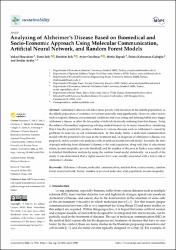| dc.contributor.author | Bayraktar, Yüksel | |
| dc.contributor.author | Işık, Esme | |
| dc.contributor.author | Işık, İbrahim | |
| dc.contributor.author | Özyılmaz, Ayfer | |
| dc.contributor.author | Toprak, Metin | |
| dc.contributor.author | Kahraman Güloğlu, Fatma | |
| dc.contributor.author | Aydın, Serdar | |
| dc.date.accessioned | 2022-07-18T10:29:34Z | |
| dc.date.available | 2022-07-18T10:29:34Z | |
| dc.date.issued | 2022 | en_US |
| dc.identifier.citation | Bayraktar, Y., Isik, E., Isik, I., Ozyilmaz, A., Toprak, M., Kahraman Guloglu, F., & Aydin, S. (2022). Analyzing of Alzheimer’s Disease Based on Biomedical and Socio-Economic Approach Using Molecular Communication, Artificial Neural Network, and Random Forest Models. Sustainability, 14(13), 7901. | en_US |
| dc.identifier.issn | 2071-1050 | en_US |
| dc.identifier.uri | https://doi.org/10.3390/su14137901 | |
| dc.identifier.uri | https://hdl.handle.net/20.500.12899/1152 | |
| dc.description | Academic Editor: Mihajlo (Michael) Jakovljevic | en_US |
| dc.description | Received: 7 June 2022 / Revised: 24 June 2022 / Accepted: 26 June 2022 / Published: 28 June 2022 | en_US |
| dc.description | (This article belongs to the Special Issue Global Health and Sustainable Development) | en_US |
| dc.description.abstract | Alzheimer’s disease will affect more people with increases in the elderly population, as the elderly population of countries everywhere generally rises significantly. However, other factors such as regional climates, environmental conditions and even eating and drinking habits may trigger Alzheimer’s disease or affect the life quality of individuals already suffering from this disease. Today, the subject of biomedical engineering is being studied intensively by many researchers considering that it has the potential to produce solutions to various diseases such as Alzheimer’s caused by problems in molecule or cell communication. In this study, firstly, a molecular communication model with the potential to be used in the treatment and/or diagnosis of Alzheimer’s disease was proposed, and its results were analyzed with an artificial neural network model. Secondly, the ratio of people suffering from Alzheimer’s disease to the total population, along with data of educational status, income inequality, poverty threshold, and the number of the poor in Turkey were subjected to detailed distribution analysis by using the random forest model statistically. As a result of the study, it was determined that a higher income level was causally associated with a lower risk of Alzheimer’s disease. | en_US |
| dc.language.iso | en | en_US |
| dc.publisher | Multidisciplinary Digital Publishing Institute (MDPI) | en_US |
| dc.relation.ispartof | Sustainability | en_US |
| dc.rights | info:eu-repo/semantics/openAccess | en_US |
| dc.subject | Alzheimer’s disease | en_US |
| dc.subject | Molecular communication | en_US |
| dc.subject | Amyloid beta | en_US |
| dc.subject | Socioeconomic | en_US |
| dc.subject | Random forest | en_US |
| dc.subject | Turkey | en_US |
| dc.subject | Number of received molecules | en_US |
| dc.subject | Total population | en_US |
| dc.subject | İncome inequality | en_US |
| dc.title | Analyzing of Alzheimer’s Disease Based on Biomedical and Socio-Economic Approach Using Molecular Communication, Artificial Neural Network, and Random Forest Models | en_US |
| dc.type | Article | en_US |
| dc.authorid | 0000-0002-6179-5746 | en_US |
| dc.department | MTÖ Üniversitesi, Darende Meslek Yüksekokulu, Tıbbi Hizmetler ve Teknikler Bölümü | en_US |
| dc.institutionauthor | Işık, Esme | |
| dc.identifier.doi | 10.3390/su14137901 | |
| dc.identifier.volume | 14 | en_US |
| dc.identifier.issue | 13 | en_US |
| dc.identifier.startpage | 1 | en_US |
| dc.identifier.endpage | 15 | en_US |
| dc.relation.publicationcategory | Makale - Uluslararası Hakemli Dergi - Kurum Öğretim Elemanı | en_US |
| dc.identifier.scopus | 2-s2.0-85133420339 | en_US |
| dc.identifier.scopusquality | Q1 | en_US |
| dc.identifier.wos | WOS:000822141300001 | en_US |
| dc.identifier.wosquality | Q2 | en_US |
| dc.indekslendigikaynak | Web of Science | en_US |
| dc.indekslendigikaynak | Scopus | en_US |


















